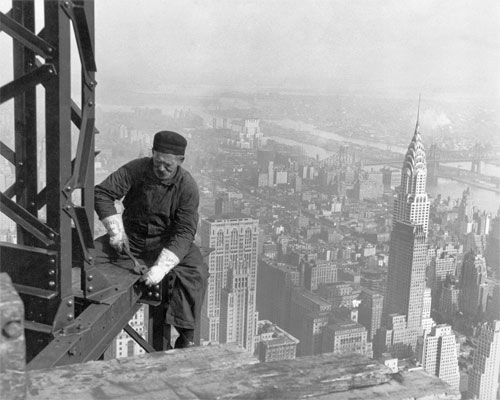Steel Frame Structure
What people might call "the skeleton of the building"
- I-beams in a regular grid
- Made construction of skyscrapers possible
- Needs to be protected from fire
- Allows huge variety of architectural skins.
Get 13 % discount by ordering before March 31.

Steel frame usually refers to a building technique with a "skeleton frame" of vertical steel columns and horizontal I-beams, constructed in a rectangular grid to support the floors, roof and walls of a building which are all attached to the frame. The development of this technique made the construction of the skyscraper possible.
Wide sheets of steel deck can be used to cover the top of the steel frame as a "form" or corrugated mold, below a thick layer of concrete and steel reinforcing bars. Another popular alternative is a floor of precast concrete flooring units with some form of concrete topping. Often in office buildings the final floor surface is provided by some form of raised flooring system with the void between the walking surface and the structural floor being used for cables and air handling ducts.
The frame needs to be protected from fire because steel softens at high temperature and this can cause the building to partially collapse. In the case of the columns this is usually done by encasing it in some form of fire resistant structure such as masonry, concrete or plasterboard. The beams may be cased in concrete, plasterboard or sprayed with a coating to insulate it from the heat of the fire or it can be protected by a fire resistant ceiling construction. Asbestos was a popular material for fireproofing steel structures up until the early 1970s, before the health risks of asbestos fibres were fully understood.
The exterior "skin" of the building is anchored to the frame using a variety of construction techniques and following a huge variety of architectural styles. Bricks, stone, reinforced concrete, architectural glass, sheet metal and simply paint have been used to cover the frame to protect the steel from the weather.
In the United States, the first steel framed building was the Rand McNally Building in Chicago, erected in 1890. (The Home Insurance Building, completed in 1885, is referred to as the first to use skeleton frame construction, but it relies on the masonry cladding for its stability. In this case the iron columns are merely embedded in the walls, and their load carrying capacity appears to be secondary to the capacity of the masonry, particularly for wind loads).